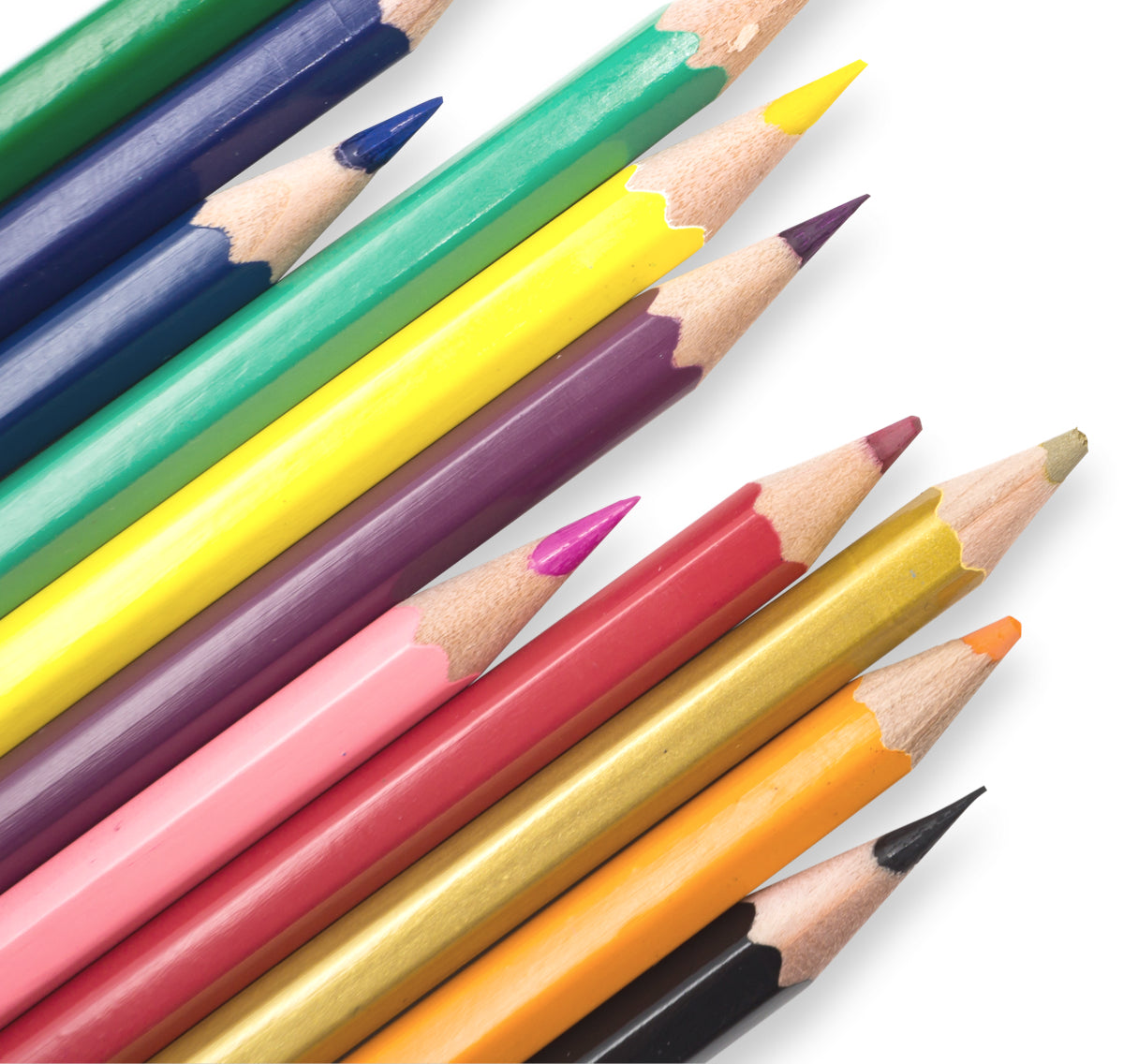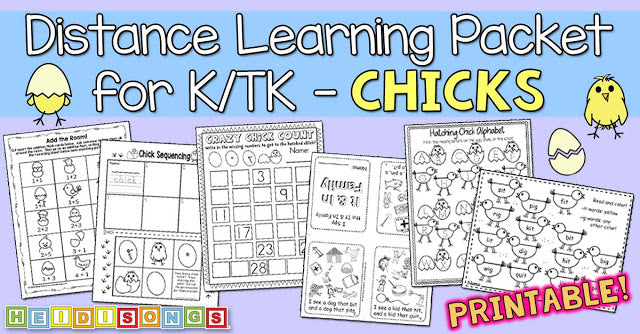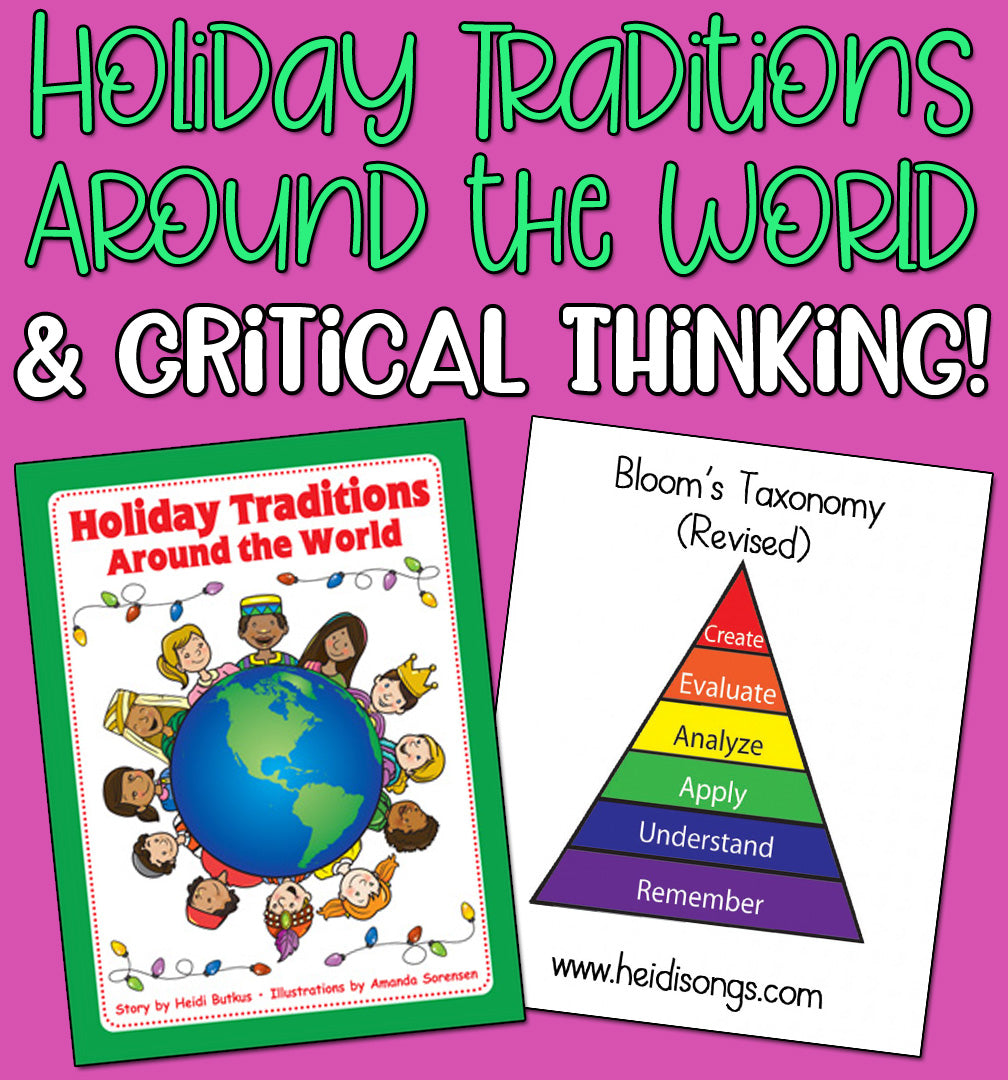
Today I have some FREE downloadable questions & activities for teaching critical thinking skills with Holiday Traditions Around the World to kindergarten, first, and second graders! Okay, I know, I know. I bet you're thinking that you are way too busy to even bother with critical thinking right now! But truthfully, this is a GREAT time to include critical thinking in your curriculum, because children are usually highly engaged in learning about anything that has to do with the holidays! Plus, we are just talking about asking a few questions while you read! We can fit that in, right? YES! Be sure to scroll all the way to the bottom to get a free downloadable copy of these questions that you can print out and take into your classroom. And just in case you're wondering, I've included questions from Bloom's Taxonomy or Webb's Depth of Knowledge.
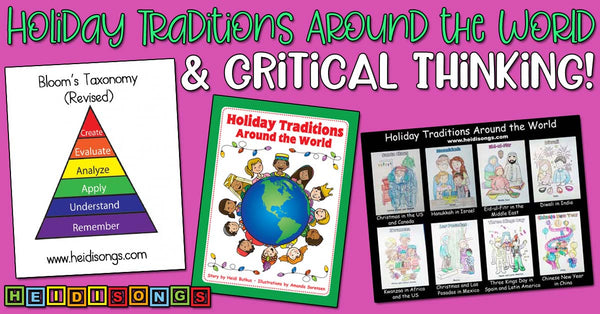
There is one thing for certain: most kids LOVE to talk, and critical thinking for young children is mostly giving them lots of chances to talk! So an added benefit is that it develops language. In fact, the hardest part of any lesson in critical thinking is getting the children to STOP talking (and listen when they should!)- because once someone offers up an idea, LOTS of children will want to contribute their thinking as well! The key is to make sure that children begin to realize that there are no wrong answers in critical thinking, give them lots of opportunities to develop oral language, and encourage them to keep thinking! The worst thing that could happen is for them to say nothing, or for them to keep talking when it is not their turn, which leads to a classroom environment that feels somewhat chaotic and one that is not conducive for shy children to have a chance to share.
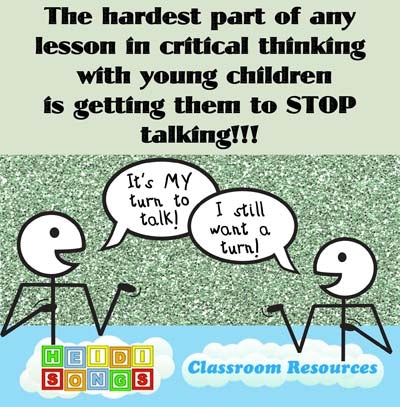
TIP! Sometimes it is easiest to give children a teddy bear or something real that they can hold when it is their turn to talk. It helps them understand better whose turn it is. :)
Using a unit in Holidays Around the World to start critical thinking discussions is a great idea because you are using informational text- and we all know how the Common Core State Standards emphasize nonfiction! However, it does include fictional elements in it, since it discusses holiday characters such as Santa, Pere Noel, Sinterklaas, Saint Nick, etc., so it shouldn't feel too "dry" to children. Just mix in celebrations from places around the world that celebrate other holidays, and sprinkle in the more familiar "Christmassy" celebrations in between (or whatever works best for your student population.)
It can sometimes be difficult to keep children engaged in critical thinking discussions long enough without them getting too restless while you let everyone have a chance to share. One way to work around this is to begin the lesson, and when kids seem to get too restless, pass out one of the coloring pages below for the country you are studying. Then let them color it in small groups while you go from group to group, stop one group and ask the children more critical thinking questions and give them more chances to share. I recommend that you mix your students heterogeneously by oral language ability in these groups, so that your English Language Learners or those with less developed language abilities can learn from interacting with their peers with further developed English language skills.
As far as the highest levels of critical thinking are concerned, educators sometimes assume that young children cannot get there because they cannot write much yet. However, remember that stories and ideas can be dictated orally and written by an adult, or simply be told orally by very young children and not written down at all. Remember that even adults who are paralyzed have written books by dictating them to others! Children are still thinking creatively and critically even when they are not writing their thinking down! In fact, they are probably freed to think more creatively when they are not restricted to what they are able to write.

These are just eight of the fifteen holidays/countries that are included in the HeidiSongs Holiday Traditions Around the World Book. Countries covered include: Christmas in Denmark & Norway, Spain & Latin America, France, Italy, Holland, Germany, England, Mexico, Ireland, United States & Canada, Hanukkah in Israel, Kwanzaa for African-Americans, Eid-ul-Fitr in the Middle East, Diwali in India, and Chinese New Year in China.
There are many ways of leveling, measuring, and thinking about critical thinking skills, but there the two major taxonomies that I hear about most frequently: Bloom's Taxonomy, and Webb's Depth of Knowledge. I have categorized my critical thinking questions according to both Bloom's Taxonomy (the revised version) and Webb's Depth of Knowledge (DOK), since the teachers that I surveyed said that they use both, depending on where they teach. Neither one of the systems seems to be much more widely accepted over the other, although many people seem to think that DOK is better aligned with the Common Core State Standards. So far, I have not found Webb's DOK mentioned specifically in the Common Core! If you have found it somewhere in there, I would love to know about it! Please let me know in the comments section.

I have done my best to compare the Blooms Taxonomy vs. Webb's Depth of Knowledge and explain them both in plain English that seems useful to me as a teacher of primary children! You can download the pictures from this post and the descriptions here. In doing this, I have pulled my information from multiple sources on the internet, (you can find most of them on my Pinterest Board for Critical Thinking). I have also drawn some conclusions of my own, because there was almost no information online for applying Bloom's or DOK to instruction for young children! So at the risk of setting myself up for criticism, I would invite you all to let me know if you disagree with any of my categorizations for the questions. Please also let me know if you disagree with my descriptions for each of the levels of critical thinking as well! I want this to be as useful as possible to as many people as possible, because it was quite time consuming to figure it all out! However, I do think that if we wind up with a way to define the different levels of critical thinking in a way that is clear and useful to teachers of young children, then it will all be worth it!
To say that “this level in Bloom’s is the same as that level in DOK,” is really an over-simplification, because of the requirement of complexity in DOK! So even though it may seem like a simple correlation, it’s really NOT! Each question must be looked at individually against the definition of each level. For example, comparing two characters in the same story would be a DOK level two question, but comparing to characters from two different stories would probably be a level three DOK, because the student must think more complexly about two different texts. So be careful in classifying your questions into one level of critical thinking or another!

All of the questions below were generated just from the information on this page from my Holiday Traditions Around the World book, with the exception of a few at the very end.
All of the questions I came up with were generated based on reading just ONE page pictured above from my Holiday Traditions Around the World Book, with the exception of a few of the very last questions on the highest level of Webb's Depth of Knowledge, which require multiple sources of information. In that case, I pulled in information from other parts of my Holiday Traditions Book, which can be found here either as a download or in print. My assumption is that once you see how to formulate the questions for one of these traditions, it would probably not be too hard to come up with more questions for the rest of them! In any case, I formulated critical thinking questions for three of the countries (or regions) and their traditions in my book, and am giving all three of them to you as free downloads today. Just click on the links below. (If they are popular and there is a demand, I could write more for sale, though!) I have also written out the questions for Norway and Denmark below.
1. Norway and Denmark (The Jul Nisse)
2. France (Pere Noel)
3. Spain and Latin America (Three Kings Day)
Both the printed version and the downloadable version of the HeidiSongs Holiday Traditions book come with student coloring pages for children to do when you are done talking, if you choose! I like to let children chat (and even sing!) while they color the pictures! It creates some extra time for discussion without the pressure of children getting restless while one child is talking.
Here is the text from my Holiday Traditions book (from the page pictured above) that I would read to the children before asking any of these questions.
"Christmas and the Jul Nisse Norway and Denmark: In Norway and Denmark, an elf called the Jul Nisse brings presents to children, but also plays jokes on people! On Christmas Eve, families leave a bowl of rice pudding or porridge out for him so that he is friendly and plays only nice jokes."
Questions from All Levels of Bloom’s Taxonomy for Holiday Traditions Around the World

Level 1: Remember
(This refers to concrete information straight from the story. No guess work!)
Who brings presents to the children in Norway and Denmark?
What else does he do other than bring presents?
When does the Jul Nisse visit?
Where does the Jul Nisse go? (What countries?)
Why does the Jul Nisse sometimes play jokes on people?
How do families get him to play only nice jokes?
Level 2 Bloom's: Understand
(This is the ability to grasp meaning from the text and understand it well enough so that you can explain it in your own words.)
Tell me how they celebrate Christmas in Norway and Denmark.
Act out how the what happens in Denmark and Norway during the holidays.
Draw me a picture of how they celebrate Christmas in Norway and Denmark and tell me about it.
Color a picture of how they celebrate Christmas in Norway and Denmark, and then write me a few sentences that tell how it is celebrated.
Level 3 Bloom's: Apply
(This is the ability to use or apply what you’ve learned in a concrete way, such as predicting, dramatizing, sequencing, solving problems, and applying the situation to your own life.)
Predict: What would happen if the families put out some spinach and broccoli for the Jul Nisse?
Sequence: What happens first when the Jul Nisse comes? What happens last when the Jul Nisse comes?
Apply the situation to your own life: If you lived in Norway or Denmark, would you leave the Jul Nisse rice pudding and porridge, or spinach and broccoli? Why?
Level 4 Bloom's: Analyze
(This is the ability to break down the different parts of the material and distinguish between them. Includes compare and contrast, classify and categorize, cause and effect, infer, and draw conclusions, and experiment or postulate.)
Compare & Contrast: How is the Jul Nisse the same as Santa? How is he different?
Classify & categorize: Is the Jul Nisse real or make believe? Why do you think so?
Classify & categorize: What kind of person or character is the Jul Nisse? (ie., an elf)
Cause & Effect: What do you think caused the Jul Nisse to be a kind of mean elf?
Experimentation or postulation: What else do you think you could give the Jul Nisse if you ran out of porridge and rice pudding, but still wanted him to be friendly and play nice jokes?
Infer, or make guesses at what has NOT been said: What kind of things do you think the Jul Nisse would do if he played a nice/mean joke?
Level 5 Bloom's: Evaluate
(This is the ability to judge, rate, or form an opinion on material for a given purpose and explain why you think so.)
Rate: Do you think it is better to have Santa visit during the holidays or the Jul Nisse to visit, or something else? Put your choices in order from best to worst.
Judge: Do you think that the Jul Nisse is a good elf or a bad elf? Explain why you think so.
Evaluate: Is the Jul Nisse the best elf to visit during the holidays, or not the best elf? Why, or why not? Form an opinion: Do you like the Jul Nisse? Why or why not? Would you like to live in Norway or Denmark during the holiday season? Why or why not? Graph where the class would like to live during the holidays based on each country’s holiday traditions.
Level 6 Bloom's: Create!
(This is the ability to put parts together to create something new and unique. It includes activities such as adapting the elements of an existing story to create a new one, connecting ideas from one text to another to create a new story, and creative project based learning activities that give children the opportunity to create something new.)
Connect ideas from one text to another: Get some blocks to build with and cut out some pictures from the holiday book of the different characters and props or objects that are in it. (Real objects are even better!) Have the children build a new setting for a certain holiday character and tell a new story to a friend about what your new character did during the holidays.
Adapt the story and create a new one: Take the Jul Nisse and put him in France. Would he ride in on a donkey? Would he still play tricks on people or would he always be nice? Write a class story (or your own story) about the Jul Nisse holiday in France.
Adapt the story and create a new one: Suppose La Befana from Italy gave her broom to Sinterklaas in Holland and Sinterklaas gave his white horse to La Befana? What would the children think or do if they saw La Befana on a white horse or Sinterklaas riding a broom? Do a “Think, Pair, Share” activity and talk about it. (Pair up and think about it, and then share out with the group.) Brainstorm ideas and write stories, or make up a class story and have everyone draw a picture.
Adapt the story and create a new one: Think about the Hanukah menorah with candles on it and the tradition of putting a candle in the windows of Ireland. How are they the same or different? Write a story of an Irish family celebrating Christmas in Israel, or an Israeli family celebrating Hanukkah in Ireland. What would they do? (You could also do this with Kwanzaa and Diwali.)
Adapt the story and create a new one: Thinking about all of the different holiday traditions we have learned about, make up your own holiday character that either brings presents or plays tricks on children. What would he or she do? Don’t forget to draw a picture!
Creative Project Based Learning Activities That Also Include Critical Thinking Skills: Holidays often include feasts! Think about the Eid-ul-Fitr feast, the parties with food and games in Mexico for Las Posadas, the Kwanzaa feast, the big special dinners for Chinese New Years, and the Diwali parties with candies and snacks. Can you create one new dish you could serve that would have something in it from each culture (like a casserole or soup?) Now plan and design the greatest feast EVER!
Creative Project Based Learning Activities That Also Include Critical Thinking Skills: Create your own fictional holiday that has some elements from at least three of the different holidays around the world. Think of a name for your holiday! Design invitations and send them out to parents, friends, or family members. Plan and cook a feast that has some foods from each culture’s holiday, and serve it to the parents that come to the holiday celebration. Make gifts that have something to do with the cultures you studied for the people that come!
Creative Project Based Learning Activities That Also Include Critical Thinking Skills: Write a holiday play that contains characters from at least three of the cultures you studied. There should be a setting, a main character, a beginning, middle, and a conclusion. Cast your play from the students in the room and then think of some easy costumes or hats you could use to help put it on! Gather props and practice your play. Can you think of any music to include? Make invitations and distribute them to parents, friends, and family members. Create a program for your special show that you could pass out to those that attend; it should have the cast members names and other credits on it. Then perform your play!
Questions from All Levels of Webb’s Depth of Knowledge for Holiday Traditions Around the World
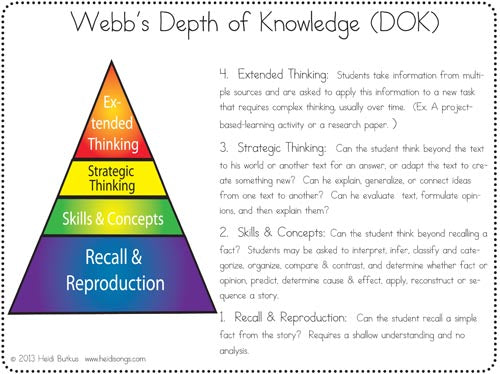
Level 1 DOK: Recall & Reproduction
Can the student recall a simple fact from the story? Requires a shallow understanding and no analysis. This is correlates fairly directly to Bloom’s Taxonomy at the bottom two levels (Understand & Remember). So I just took all of questions from those two levels and put them here:
Basic Recall and Comprehension Questions:
Who brings presents to the children in Norway and Denmark?
What else does he do other than bring presents?
When does the Jul Nisse visit?
Where does the Jul Nisse go? (What countries?)
Why does the Jul Nisse sometimes play jokes on people?
How do families get him to play only nice jokes?
Tell me how they celebrate Christmas in Norway and Denmark.
Act out how the what happens in Denmark and Norway during the holidays.
Draw me a picture of how they celebrate Christmas in Norway and Denmark and tell me about it.
Color a picture of how they celebrate Christmas in Norway and Denmark, and then write me a few sentences that tell how it is celebrated.
Level 2 DOK: Skills & Concepts
Can the student think beyond recalling a fact? Students may be asked to interpret, infer, classify and categorize, organize, compare & contrast, and determine whether fact or opinion, predict, determine cause & effect, apply, reconstruct or sequence a story, Some of the questions from BOTH the third and fourth levels of Blooms fit here! It depends on the complexity of the question.
I think that almost all of the questions I wrote for both the third and fourth level of Bloom’s Taxonomy fit in here because we are only talking about one text at a time. The question I wrote for “experimentation and postulation” doesn’t fit here because the child must think beyond the text to get the answer. Generally, if you can get the kids to think about more than one text at a time, think beyond the text to get the answer, and get them to formulate opinions, you’ll have hit the third level in DOK.
Predict: What would happen if the families put out some spinach and broccoli for the Jul Nisse?
Sequence: What happens first when the Jul Nisse comes? What happens last when the Jul Nisse comes?
Apply the situation to your own life: If you lived in Norway or Denmark, would you leave the Jul Nisse rice pudding and porridge, or spinach and broccoli? Why?
Compare & contrast: How is the Jul Nisse the same as Santa? How is he different?
Classify & categorize: Is the Jul Nisse real or make believe? Why do you think so?
Classify & categorize: What kind of person or character is the Jul Nisse? (ie., an elf)
Cause & effect: What do you think caused the Jul Nisse to be a kind of mean elf? Why do you think so?
Infer: What kind of things do you think the Jul Nisse would do if he played a nice/mean joke?
Level 3 DOK: Strategic Thinking
Can the student think beyond the text to his world or another text for an answer, or adapt the text to create something new? Can he explain, generalize, or connect ideas from one text to another? Can he evaluate text, formulate opinions, and then explain them? Summarizing information from multiple sources falls into this category as well.
Experimentation or postulation: What else do you think you could give the Jul Nisse if you ran out of porridge and rice pudding, but still wanted him to be friendly and play nice jokes? Why?
Rate: Do you think it is better to have Santa visit during the holidays or the Jul Nisse to visit, or something else? Put your choices in order from best to worst and explain your choices.
Judge: Do you think that the Jul Nisse is a good elf or a bad elf? Explain why you think so.
Evaluate: Is the Jul Nisse the best elf to visit during the holidays, or not the best elf? Why, or why not? Form an opinion: Do you like the Jul Nisse? Why or why not? Would you like to live in Norway or Denmark during the holiday season? Why or why not? Graph where the class would like to live during the holidays based on each country’s holiday traditions. Show the class pictures of Norway and Denmark using Google Earth or by some other method to help them decide.
Connect ideas from one text to another: Get some blocks to build with and cut out some pictures from the holiday book of the different characters and props or objects that are in it. (Real objects are even better!) Have the children build a new setting for a certain holiday character and tell a new story to a friend about what your new character did during the holidays.
Adapt the story and create a new one: Take the Jul Nisse and put him in France. Would he ride in on a donkey? Would he still play tricks on people or would he always be nice? Write a class story (or your own story) about the Jul Nisse holiday in France.
Adapt the story and create a new one: Suppose La Befana from Italy gave her broom to Sinterklaas in Holland and Sinterklaas gave his white horse to La Befana? What would the children think or do if they saw La Befana on a white horse or Sinterklaas riding a broom? Do a “Think, Pair, Share” activity and talk about it. (Pair up and think about it, and then share out with the group.) Brainstorm ideas and write stories, or make up a class story and have everyone draw a picture.
Adapt the story and create a new one: Think about the Hanukah menorah with candles on it and the tradition of putting a candle in the windows of Ireland. How are they the same or different? Write a story of an Irish family celebrating Christmas in Israel, or an Israeli family celebrating Hanukkah in Ireland. What would they do? (You could also do this with Kwanzaa and Diwali.)
Adapt the story and create a new one: Thinking about all of the different holiday traditions we have learned about, make up your own holiday character that either brings presents or plays tricks on children. What would he or she do? Don’t forget to draw a picture!
----- (I added these questions to this section, although they were not included above for Bloom's.) -----
Experimentation: Suppose I wanted to find out what would happen if I left the Jul Nisse broccoli and spinach, what should I do? Should I try this at my own house or someone else’s house? Why or why not?
Compare & contrast: (This question assumes you have already read about holiday traditions in France and Italy.) Who would visit your family if you were born in France and lived there until you were five, and then moved to Denmark or Norway? And then when you were seven, your family moved to Italy? Would Pere Noel, La Befana, AND the Jul Nisse all visit you? Or would just one? If so, which one? Why????
Level 4 DOK: Extended Thinking
Students take information from more than one source and are asked to apply this information to a new task that includes complex thinking, usually over time. (Ex. A project-based-learning activity for younger students. For older students, this could include a research project or term paper.)
Holidays often include feasts! Think about the Eid-ul-Fitr feast, the parties with food and games in Mexico for Las Posadas, the Kwanzaa feast, the big special dinners for Chinese New Years, and the Diwali parties with candies and snacks. Now plan and design the greatest feast EVER! Can you create one new dish you could serve that would have something in it from each culture (like a casserole or soup?)
Create your own fictional holiday that has some elements from at least three of the different holidays around the world. Think of a name for your holiday! Design invitations and send them out to parents, friends, or family members. Plan and cook a feast that has some foods from each culture’s holiday, and serve it to the parents that come to the holiday celebration. Make gifts that have something to do with the cultures you studied for the people that come!
Write a holiday play that contains characters from at least three of the cultures you studied. There should be a setting, a main character, a beginning, middle, and a conclusion. Cast your play from the students in the room and then think of some easy costumes or hats you could use to help put it on! Gather props and practice your play. Can you think of any music to include? Make invitations and distribute them to parents, friends, and family members. Create a program for your special show that you could pass out to those that attend; it should have the cast members names and other credits on it. Then perform your play!
I hope you get a chance to try some of these questions out with your class! Please let me know how it goes if you do! You can download a pdf copy of the questions from Bloom's Taxonomy here. You can download a copy of the questions from Webb's Depth of Knowledge here.
Need more help teaching critical thinking skills to Kindergarten, first, or second graders? I also made some Critical Thinking Question Cards that you can download here for just $3. They are SO helpful for coming up with critical thinking questions at the spur of the moment! Once you get the hang of it, you'll wonder why you ever thought this was hard!
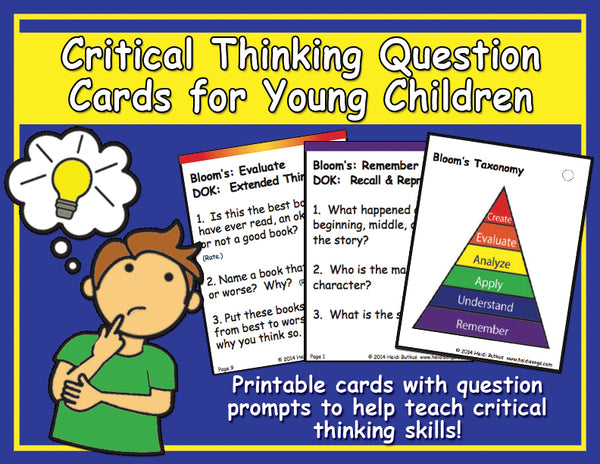
And remember... HeidiSongs has TONS of resources to help you teach all kinds of things, including sight words, math, phonics, alphabet, counting and number recognition, learning to sound out three letter words, and MORE!

----------------------------------
Follow me! Did you enjoy this post? Do me a favor and share it with your friends! And follow this blog by signing up for my email updates, or follow on Bloglovin', or follow me on TPT! I'm also on Pinterest, Facebook, Twitter, Instagram, Google+ and YouTube, too! Don't forget to sign up for our email newsletter (at the bottom of this page) for special deals and promo codes that you won't find out about anywhere else.



